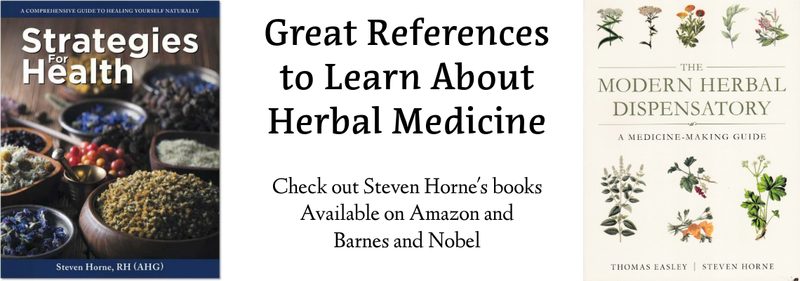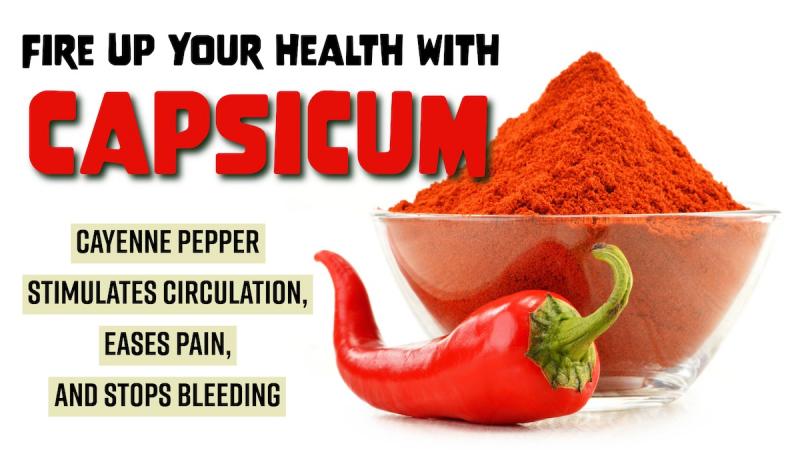
Known in the culinary world as cayenne and in the herb world as capsicum, red pepper is one of my favorite spices. But, it wasn’t always that way. I didn’t like spicy food when I was young, but acquired a taste for it in my early 20s when I started eating it to improve my health. And I’ve been addicted to it ever since. So when a friend of mine made herbal t-shirts many years ago, my favorite had to be the one that said , “I’m hot on herbs.” with a picture of a spicy red pepper.
Capsicum is a genus in the nightshade family (Solanaceae). Most popular peppers belong to the species Capsicum annuum, which contains bell peppers, jalapeño peppers, paprika, and cayenne. However, there is a hotter species of red pepper that’s also used medicinally from the species C. frutescens. This group contains African redbird cayenne and the pepper used to make Tabasco sauce. The hottest group of all is C. chinense, which contains the habanero and Scotch bonnet varieties.
All these species and varieties of capsicum peppers have one thing in common. They all originated with the natives in South and Central America. They were introduced to the world in the 1500s via Spanish explorers and Portuguese traders. And are now an important part of many cuisines.
Measuring the Heat
 The heat of peppers is due to a group of compounds known as capsaicinoids, the most widely known being capsaicin. The more capsaicin a variety contains, the hotter the pepper. The strength of the heating sensation is measured in Scoville heat units (HU), named after the American pharmacist, Wilbur Scoville. He devised a test to measure heat in 1912 by testing how much sugar water it took to dilute a pepper extract until a person could no longer sense the heat. Today, the rating is done by directly measuring the amount of capsaicin in the peppers.
The heat of peppers is due to a group of compounds known as capsaicinoids, the most widely known being capsaicin. The more capsaicin a variety contains, the hotter the pepper. The strength of the heating sensation is measured in Scoville heat units (HU), named after the American pharmacist, Wilbur Scoville. He devised a test to measure heat in 1912 by testing how much sugar water it took to dilute a pepper extract until a person could no longer sense the heat. Today, the rating is done by directly measuring the amount of capsaicin in the peppers.
The capsicum used in herbal medicine generally varies from 30,000 to 50,000 HU. The African red bird cayenne, favored by Utah herbalist John Christopher runs between 50-100,000 HU. Jalapeño peppers and Tabasco sauce, which I also love, are rated at only 2,500 to 8,000 HU, while habanero peppers run between 100-350,000 HU. There’s even a ghost chili pepper that runs around one million HU.
As a little tip, if you do eat food that’s too spicy for you, don’t drink water to cool down your mouth. Capsaicinoids aren’t water-soluble. They’re fat soluble. So, extinguish the heat with something that contains fat, like sour cream, whole milk, ice cream, cheese, or a spoonful of coconut oil.
Capsaicin
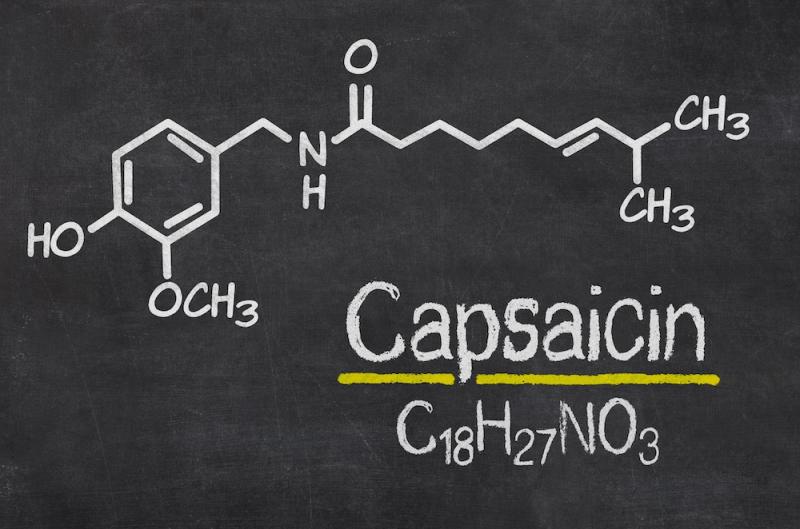 Capsaicin has been extensively studied and is approved as a standalone drug. It doesn’t actually burn your mouth, it just attaches to nerve receptors for heat and stimulates them, giving you the sensation of heat. It also binds to receptor sites for a neurotransmitter called substance P, which communicates pain signals. Upon repeated application it depletes these neurotransmitters, resulting in a temporary relief from pain. It also suppresses chemical messaging systems that activate inflammation, so in spite of its spicy taste, it actually reduces inflammation.
Capsaicin has been extensively studied and is approved as a standalone drug. It doesn’t actually burn your mouth, it just attaches to nerve receptors for heat and stimulates them, giving you the sensation of heat. It also binds to receptor sites for a neurotransmitter called substance P, which communicates pain signals. Upon repeated application it depletes these neurotransmitters, resulting in a temporary relief from pain. It also suppresses chemical messaging systems that activate inflammation, so in spite of its spicy taste, it actually reduces inflammation.
Pure capsaicin is around 15 to 16 million HU and is used to make pepper spray. When sprayed into the eyes of an attacking person or animal, it can temporarily blind them and ward off the attack.
Stimulating Circulation
Capsicum can be used to help ease pain and reduce inflammation, either applied topically or taken internally, but its major use in herbal medicine is as a circulatory stimulant. It increases circulation to every area of the body. It also strengthens the heartbeat.
I read in older herb books that capsicum equalized the circulation. I finally figured out why they said this when I learned that it corrected an uneven pulse. When you feel the pulse on both sides of the body at the same time, you’ll sometimes notice that the two sides are not in sync. The pulse on one side of the body lags slightly behind the pulse on the other side. It’s as if the body is working harder to get blood to that half of the body.
The first time I experienced this I was blown away by what I observed. After feeling an uneven pulse I went and got a bottle of capsicum. I put it on the person’s lap and the two pulses immediately synchronized. I took the bottle off their lap and the pulses were uneven again. I set it back on their lap and the pulse again became even. I even had a person I was with try it, and they could feel it as well. I’ve done it several times since and it always worked.
Blood Flow Aids Healing
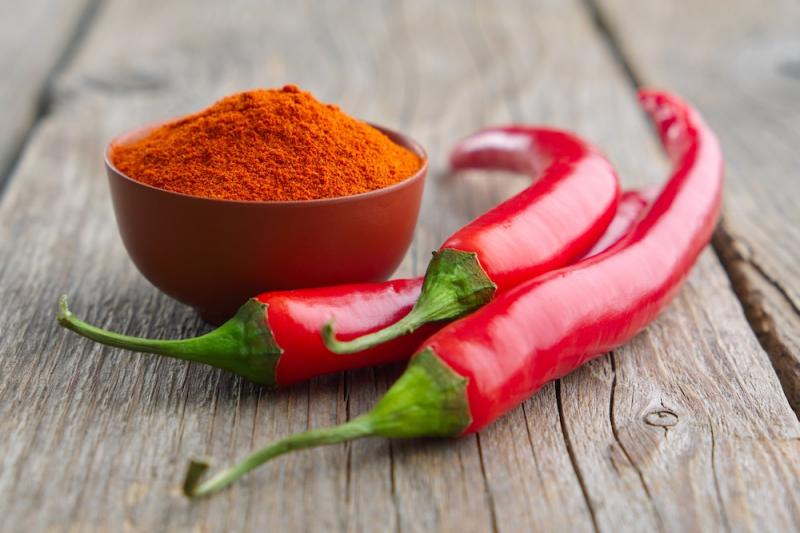 Because adequate blood supply is necessary for all tissues to heal, capsicum has earned a reputation in the West as a cure-all. It was pioneer herbalist Samuel Thomson who promoted the use of lobelia and capsicum internally for just about everything. Lobelia was his number one herb and capsicum his number two.
Because adequate blood supply is necessary for all tissues to heal, capsicum has earned a reputation in the West as a cure-all. It was pioneer herbalist Samuel Thomson who promoted the use of lobelia and capsicum internally for just about everything. Lobelia was his number one herb and capsicum his number two.
While these two herbs aren't cure-alls, they do work together to ease a wide variety of problems. For instance, I’ve often used capsicum and lobelia topically to help ease pain and promote healing. The lobelia relaxes muscle tension and aids lymph flow, while the capsicum reduces pain and stimulates circulation. This helps the tissues get the oxygen, nutrients, and waste removal they need to heal. I’ve used this technique for chronic neck pain, back pain, and arthritic joints.
John Christopher used small amounts of capsicum and lobelia in many of his formulas to make them work faster. I think that capsicum can act as a catalyst for other remedies, aiding both their absorption into the body and their distribution throughout the body. Capsicum may also prevent the liver from breaking down constituents of other herbs so that they remain longer in the bloodstream.
Capsicum for Shock and Heart Attacks
Capsicum can even be used in emergency situations to ease shock and possibly save lives. When a person goes into shock, blood moves away from the extremities and into the core of the body, leaving the person feeling pale and cold. A small amount of capsicum extract or powder, administered by mouth can ease the shock and restore color and warmth by improving circulation.
Capsicum can be used in the same manner to help a person who is experiencing a heart attack or stroke. I experienced this firsthand when I was at a conference in Australia. One of the participants started having symptoms of a heart attack and while we were waiting for the ambulance someone found some capsicum extract and hawthorn tincture. I administered small doses of each with a little water every few minutes while we were waiting.
He was feeling better when the ambulance arrived and asked me to go with him to the hospital. They discharged him in about one hour, saying that everything looked fine. I’ve heard of other people administering capsicum to someone having a heart attack who have reported similar positive results. That’s why I like to keep capsicum extract or capsules in my first aid kit and emergency supplies.
Capsicum and Pain
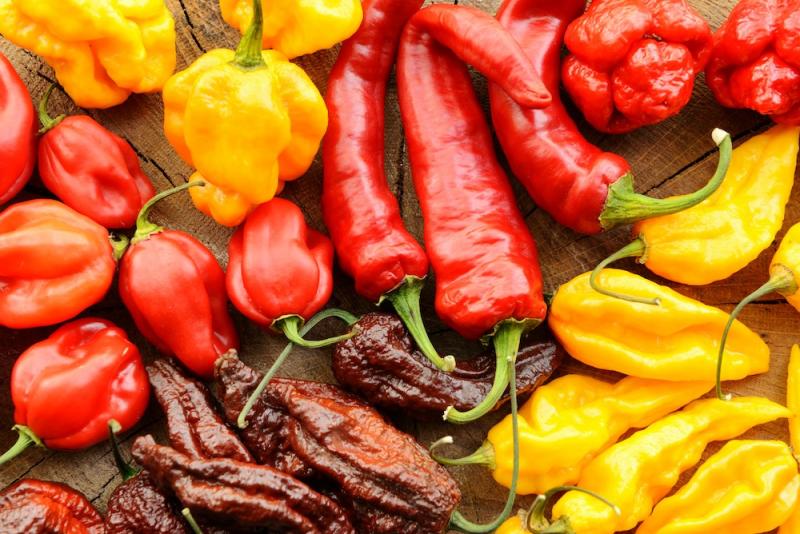 The capsaicin in capsicum doesn’t just numb the pain, it also helps ease the problem by promoting blood flow. Pain is often a sign of a lack of oxygen to the tissues. By drawing blood into the area where the pain is, capsicum also brings oxygen to the area, which promotes.
The capsaicin in capsicum doesn’t just numb the pain, it also helps ease the problem by promoting blood flow. Pain is often a sign of a lack of oxygen to the tissues. By drawing blood into the area where the pain is, capsicum also brings oxygen to the area, which promotes.
Besides using the capsicum and lobelia topically as I’ve already described, you can use capsicum or capsaicin gels or lotions. When applying these topically be sure to avoid contact with sensitive parts of the body such as the eyes and genitals.
I’ve also used capsicum in a gargle for sore throats. I’ve mixed equal parts of bayberry rootbark, goldenseal, and myrrh, with one-quarter of a part of capsicum. You make this as a strong tea or decoction and use it as a gargle. The gargle fights the infection, but it’s the capsicum that helps to provide rapid relief for the pain. Truthfully, it stings at first, but after the initial sting, it rapidly eases the pain.
Capsicum for Colds
One of the reasons I started eating spicy food in my early 20s was because it helped ease my chronic sinus problems. Capsicum acts as a decongestant and sudorific. It increases the production of mucus and sweat to flush irritants from the body. You’ve probably experienced this first-hand if you’ve eaten too much spicy food. Your nose may start to run and sweat may form on your forehead.
I discovered that you can use this effect in the early stages of a cold or flu to help the body get rid of it more quickly. Now, one of my standard tactics, when I start to feel the beginning stages of colds or respiratory congestion, is to have some tomato soup and add as much capsicum to it as I can tolerate. I eat this warm, spicy soup and try to get my sinuses to drain more to flush out the irritants more quickly and many times I’ve been able to nip the illness in the bud and avoid getting sick.
Capsicum and Bleeding
One of the interesting things about capsicum is that it also acts as a styptic, which means it helps stop bleeding. I know people who have cut themselves and sprinkled capsicum into the wound to stop the bleeding. I’ve personally never done this, but I have used capsicum internally for bleeding. The midwife who helped deliver most of my children would make a decoction of bayberry rootbark and capsicum to give to new mothers to stop postpartum bleeding. I’ve used these two herbs together to stop other types of bleeding, such as nosebleeds. I’ve also used this mixture, along with false unicorn and a small amount of lobelia, to help prevent a threatened miscarriage and spotting during pregnancy.
Capsicum has also been used for ulcers. Nature’s Sunshine Products, America’s first large herbal encapsulating company was started because founder Gene Hughes was taking capsicum internally for an ulcer and decided to put the herb in capsules so he didn’t have to swallow the powder. I haven't used capsicum for ulcers, but I assume it works because of its styptic and antimicrobial action.
Capsicum as an Emotional Remedy
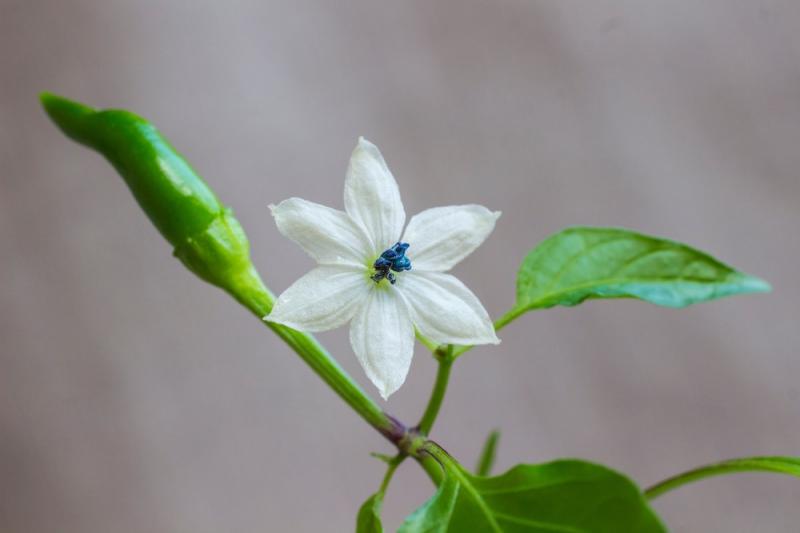 The indications for cayenne flower essence show how conditions in the mind and emotions can mirror conditions in the body. The flower essence is for people who are experiencing stagnation in their life. They lack the motivation and drive to move forward. They have phlegmatic (watery) personalities, which means they are more often too passive and unwilling to deal with conflict and confrontation. The phlegmatic personality is also prone to mucus congestion on the physical level, which is why phlegm (mucus) is found in the name.
The indications for cayenne flower essence show how conditions in the mind and emotions can mirror conditions in the body. The flower essence is for people who are experiencing stagnation in their life. They lack the motivation and drive to move forward. They have phlegmatic (watery) personalities, which means they are more often too passive and unwilling to deal with conflict and confrontation. The phlegmatic personality is also prone to mucus congestion on the physical level, which is why phlegm (mucus) is found in the name.
If you’ve ever eaten really hot peppers you know that they can not only burn on the way in, they can burn on the way out, something I experienced first-hand after eating too much of some really hot habanero salsa at a Mexican restaurant in Los Angeles. Perhaps you’ve heard of “lighting a fire under someone’s butt?” Well, metaphorically, that’s what cayenne does as a flower essence remedy. It stimulates them to move forward and start taking action to confront the challenges in their lives. In short, cayenne flower essence helps fire people up.
And, just like capsicum can be used as a catalyst in herbal formulas to make them more effective, cayenne flower essence can be used with other flower essences as a catalyst to help them work faster as well. So, if you tend to be phlegmy, wishy-washy, and unmotivated capsicum or cayenne flower essence may be a good constitutional remedy for you.
Using Capsicum
Due to its irritating nature, some people have a hard time taking capsicum. It is most commonly taken in capsules because, even though it doesn't literally burn, it can make your mouth feel like it is on fire.
Large doses can also irritate the stomach and cause painful bowel elimination. If you’re not used to taking spicy food, take one capsule of capsicum along with a capsule of marshmallow or slippery elm. You can also dilute a tincture or glycerite with a little water and chug it down. However, I almost always take capsicum with food. I sprinkle it in soups and stews and I also like to use other varieties like jalapeños and Tabasco regularly, especially with heavy, mucous-forming food like cheese.
I also use it in formulas for colds and flu, such as the sore throat gargle mentioned above, fire cider, herbal composition powder, and herbal crisis. Recipes for these formulas can be found in Modern Herbal Dispensatory and Strategies for Health.
Steven's Articles
-

-
The Health Benefits and Problems with Coffee
This popular caffeinated beverage can be beneficial…
October
-

-
Understanding Caffeine & Cellular Adaptation
Preserving the power of caffeine's buzz and the…
September
-

-
Horseradish
A pungent spice for aiding protein metabolism…
-

-
Banaba or Crepe Myrtle
A beautiful tree from Southeast Asia whose leaves…
August
-

-
Monkeyflowers
Flower essences to help see ourselves more clearly…
-

-
Mariposa Lilies
Strengthening the bond between mother and child…
-

-
The Noble Bay Leaf
A common kitchen herb for aiding digestion and…
-

-
Epimedium: Horny Goat Weed
A circulatory stimulant and kidney yang tonic…
July
-

-
The Medicinal and Nutritional Benefits of Apricots
A nutritious fruit and valuable medicinal seed for coughs
-

-
Dogwoods
Asian dogwood is used to stop excessive discharge,…
June
-

-
Neem: The Village Pharmacy
A popular Ayurvedic remedy for dental and immune…
-

-
Spilanthes: The Toothache Plant
A traditional remedy for teeth and gums, as well…
-

-
Forsythia
An anti-inflammatory, fever-reducing, and infection fighting herb
May
-

-
Buckwheat (Kashi)
A delicious, high protein, gluten-free, gut-healthy food
-

-
Leaky Gut Syndrome
Plugging the leaks on the underlying cause of…

